Research on the Effect of Pearlite Lamellar Spacing on Rolling Contact Wear Behavior of U75V Rail Steel
Abstract
:1. Introduction
2. Materials and Methods
3. Experimental Results
3.1. Effect of Pearlite Lamellar Spacing on Wear Performance of Steel
3.2. Effect of Pearlite Lamellar Spacing on the Rolling Contact Wear Behavior of Steel
3.3. Effect of Pearlite Lamellar Spacing on Machining Hardening under the Rolling Contact Surface Layer
4. Analysis and Discussion
5. Conclusions
- (1)
- The wear resistance of the samples is influenced by the pearlite lamellar spacing. The mass loss and friction coefficient of the samples decrease with the decrease of the lamellar spacing.
- (2)
- The depth of plastic deformation layer is decreased on the worn surface of the sample with the decreasing of the lamellar spacing, and the fatigue crack length and hardening rate increase.
- (3)
- The cementite lamellar of large lamellar spacing is easily fractured and spalled, while the one of medium lamellar spacing is partially broken. It is noted that the thin cementite lamellar of small spacing is bent and hardly broken. The work hardening rate is 35% for the sample with the small lamellar spacing as the plastic deformation of ferrite was hindered by the thin cementite. The plastic deformation layer is difficult to remove, and fatigue cracks are easy to initiate and extend to the interior of the material.
Author Contributions
Funding
Data Availability Statement
Conflicts of Interest
References
- Fletcher, D.I.; Franklin, F.J.; Kapoor, A. Image analysis to reveal crack development using a computer simulation of wear and rolling contact fatigue. Fatigue Fract. Eng. Mater. Struct. 2003, 26, 957–968. [Google Scholar] [CrossRef]
- Skyttebol, A.; Josefson, B.L.; Ringsberg, J.W. Fatigue crack growth in a welded rail under theinfluence of residual stresses. Eng. Fract. Mech. 2005, 72, 271–285. [Google Scholar] [CrossRef]
- Baptista, R.; Santos, T.; Marques, J.; Guedes, M.; Infante, V. Fatigue behavior and microstructural characterization of a high strength steel for welded railway rails. Int. J. Fatigue 2018, 117, 1–8. [Google Scholar] [CrossRef]
- Zerbst, U.; Lundén, R.; Edel, K.O.; Smith, R.A. Introduction to the damage tolerance behaviourof railway rails—A review. Eng. Fract. Mech. 2009, 76, 2563–2601. [Google Scholar] [CrossRef] [Green Version]
- Widiyarta, I.M.; Franklin, F.J.; Kapoor, A. Modelling thermal effects in ratchetingled wear and rolling contact fatigue. Wear 2008, 256, 1325–1331. [Google Scholar] [CrossRef]
- Jinfang, P.; Xuhui, X.; Weijun, S.; Wei, L.; Zhiping, L. Wear properties of two U71MnK and U71MnG rail steel welds during rolling contact fatigue. Int. J. Mod. Phys. B 2019, 33, 1940041. [Google Scholar]
- Godefroid, L.B.; Faria, G.L.; Cândido, L.C.; Viana, L.C. Failure analysis of recurrent cases of fatigue fracture in flash butt welded rails. Eng. Fail. Anal. 2015, 58, 407–416. [Google Scholar] [CrossRef]
- Arias-Cuevas, O.; Li, Z.; Lewis, R.; Gallardo-Hernandez, E.A. Rolling-sliding laboratory tests of friction modifiers in dry and wet wheel-rail contacts. Wear 2010, 268, 543–551. [Google Scholar] [CrossRef] [Green Version]
- Lewis, R.; Gallardo-Hernandez, E.A. Twin disc assessment of wheel/rail adhesion. Wear 2008, 265, 1309–1316. [Google Scholar]
- Lewis, R.; Dwyer-Joyce, R.S. Wear at the wheel-rail interface when sanding is used to increase adhesion. Proc. Inst. Mech. Eng. Part F 2006, 220, 29–41. [Google Scholar] [CrossRef]
- Frederick, C.O. Future rail requirements. In Rail Quality and Maintenance for Modern Railway Operation; Kluwer Academic Publishers: Dordrecht, The Netherlands, 1993; pp. 3–14. [Google Scholar]
- Matsuda, H.; Satoh, Y.; Kanematsu, Y. On-site investigation and analysis of flaking damage leading to rail break. Wear 2011, 271, 168–173. [Google Scholar] [CrossRef]
- Franklin, F.J.; Widiyarta, I.; Kapoor, A. Computer simulation of wear and rolling contact fatigue. Wear 2001, 25, 949–955. [Google Scholar] [CrossRef]
- Li, Z.; Zhao, X.; Esveld, C.; Dollevoet, R.; Molodova, M. An investigation into the causes of squats—Correlation analysis and numerical modeling. Wear 2008, 265, 1349–1356. [Google Scholar] [CrossRef]
- Yokoyama, H.; Mitao, S.; Yamamoto, S.; Fujikake, M. Effect of the angle of attack on flaking behavior in pearlitic and bainitic steel rails. Wear 2002, 235, 60–66. [Google Scholar] [CrossRef]
- Shur, E.A.; Bychkova, N.Y.; Trushevsky, S.M. Physical metallurgy aspects of rolling contact fatigue of rail steels. Wear 2005, 258, 1165–1171. [Google Scholar] [CrossRef]
- Hardwick, C.; Lewis, R.; Eadie, D.T. Wheel and rail wear-understanding the effects of water and grease. Wear 2014, 314, 198–204. [Google Scholar] [CrossRef]
- Zhu, Y.; Olofsson, U.; Söderberg, A. Adhesion modeling in the wheel-rail contact under dry and lubricated conditions using measured 3D surfaces. Tribol. Int. 2013, 61, 1–10. [Google Scholar] [CrossRef]
- Ringsberg, J.; Cyclic, W. Ratchetting and failure of a pearlitic rail steel. Fatigue Fract. Eng. Mater. Struct. 2000, 23, 747–758. [Google Scholar] [CrossRef]
- Stocka, R.; Pippanb, R. RCF and wear in theory and practice-The influence of rail grade on wear and RCF. Wear 2011, 271, 125–133. [Google Scholar] [CrossRef]
- Eadie, D.T.; Elvidge, D.; Oldknow, K.; Stock, R.; Pointner, P.; Kalousek, J.; Klauser, P. The effects of top of rail friction modifier on wear and rolling contact fatigue: Full scale rail-wheel test rig evaluation, analysis and modelling. Wear 2008, 265, 1222–1230. [Google Scholar] [CrossRef]
- Fletcher, D.I.; Beynon, J.H. Equilibrium of crack growth and wear rates during unlubricated rolling-sliding contact of pearlitic rail steel. Proc. Inst. Mech. Eng. 2000, 214, 93–96. [Google Scholar] [CrossRef]
- Donzella, G.; Faccoli, M.; Ghidini, A.; Mazzù, A.; Roberti, R. The competitive role of wear and RCF in a rail steel. Eng. Fract. Mech. 2005, 72, 287–308. [Google Scholar] [CrossRef]
- Donzella, G.; Mazzfi, A.; Petrogalli, C. Competition between wear and rolling contact fatigue at the heel-rail interface: Some experimental evidence on rail steel. Proc. Inst. Mech. Eng. Part F J. Rail Rapid Transit 2009, 223, 31–39. [Google Scholar] [CrossRef]
- Donzella, G.; Faccoli, M.; Mazzfi, A. Progressive damage assessment in the near-surface layer of railway wheel-rail couple under cyclic contact. Wear 2011, 271, 408. [Google Scholar] [CrossRef]
- Zhong, W.; Hu, J.J.; Li, Z.B.; Liu, Q.Y.; Zhou, Z.R. A study of rolling contact fatigue crack growth in U75V and U71Mn rails. Wear 2011, 271, 388–392. [Google Scholar] [CrossRef]
- Kapoor, A.; Fletcher, D.I.; Franklin, F.J. The Role of wear in enhancing rail life. In Tribology Research and Design for Engineering Systems; Elsevier BV: Amsterdam, The Netherlands, 2003; pp. 331–340. [Google Scholar]
- Tatsumi, K.; Mineyasu, T.; Minoru, H. Development of SP3 rail with high wear resistance and rolling contact fatigue resistance for heavy haul railways. JFE Techn. Rep. 2011, 16, 32–38. [Google Scholar]
- Fukuda, K.; Kataoka, Y.; Yamanaka, H.; Ueda, M. New Heat-Treated Rail with Thicker Head-Hardened Layer and Higher Toughness; Institution of Engineers: Darwin, Australia, 1989. [Google Scholar]
- Zuev, L.; Korotkikh, N.; Muratov, V.; Vorozhishchev, V.; Shipilov, A. Crack Growth During Cyclic Loading of Heat-Treated Rail Steel. Izvestiya Vysshikh Uchebnykh Zavedenij. Chernaya Metall. 1980, 10, 81–86. [Google Scholar]
- Pickering, F.B.; Garbarz, B. The effect of transformation temperature and prior austenite grain size on the pearlite colony size in vanadium treated pearlitic steels. Scr. Metall. 1987, 21, 249–253. [Google Scholar] [CrossRef]
- Kang, H.; Zhao, X.M.; Wu, D. Effect of Air Pressure on Hardened Layer of U75V 60kg/m Heavy Rail after Heat Treatment. J. Harbin Inst. Technol. 2013, 1, 5. [Google Scholar]
- Yokoyama, H.; Mitao, S.; Takemasa, M. Development of High Strength Pearlitic Steel Rail (SP Rail) with Excellent Wear and Damage Resistance. NKK Tech. Rev. 2002, 86, 59–64. [Google Scholar]
- Kaiming, W.; Bhadeshia, H.K.D.H. Extremely fine pearlite by continuous cooling transformation. Scr. Mater. 2012, 67, 53–56. [Google Scholar]
- Zheng, C.; Dan, R.; Zhang, F.; Lv, B.; Yan, Z.; Shan, J.; Long, X. Effects of retained austenite and hydrogen on the rolling contact fatigue behaviours of carbide-free bainitic steel. Mater. Sci. Eng. A 2014, 594, 364–671. [Google Scholar] [CrossRef]
- Lewis, R.; Dwyer-Joyce, R.S. Wear mechanisms and transitions in railway wheel steels. Proc. Inst. Mech. Eng. Part J J. Eng. Tribol. 2004, 218, 467–478. [Google Scholar] [CrossRef] [Green Version]
- Sheng, G.; Fan, J.; Peng, X. TEM observation of contact fatigued microstructure for PD3 rail steel. Iron Steel 1999, 34, 51–54. [Google Scholar]
- Fisher, F.D.; Daves, W.; Pippan, R.; Pointner, P. Some comments on surface cracks in rails. Fatigue Fract. Eng. Mater. Struct. 2006, 29, 938–948. [Google Scholar] [CrossRef]
- Anders, E.; Elena, K.; Jens, C.O. Nielsen. Subsurface initiated rolling contact fatigue of railway wheels as generated by rail corrugation. Int. J. Solids Struct. 2007, 44, 7975–7987. [Google Scholar]
- Braghin, F.; Lewis, R.; Dwyer-Joyce, R.S.; Bruni, S. A mathematical model to predictrailway wheel profile evolution due to wear. Wear 2006, 261, 1253–1264. [Google Scholar] [CrossRef]
- Tassini, N.; Quost, X.; Lewis, R.; Dwyer-Joyce, R.S.; Ariaudo, C.; Kuka, N. A numerical model of twin disc test arrangement for the evaluation of railway wheel wear prediction methods. Wear 2010, 268, 660–667. [Google Scholar] [CrossRef] [Green Version]
- Lewis, R.; Olofsson, U. Mapping rail wear regimes and transitions. Wear 2004, 257, 721–729. [Google Scholar] [CrossRef]
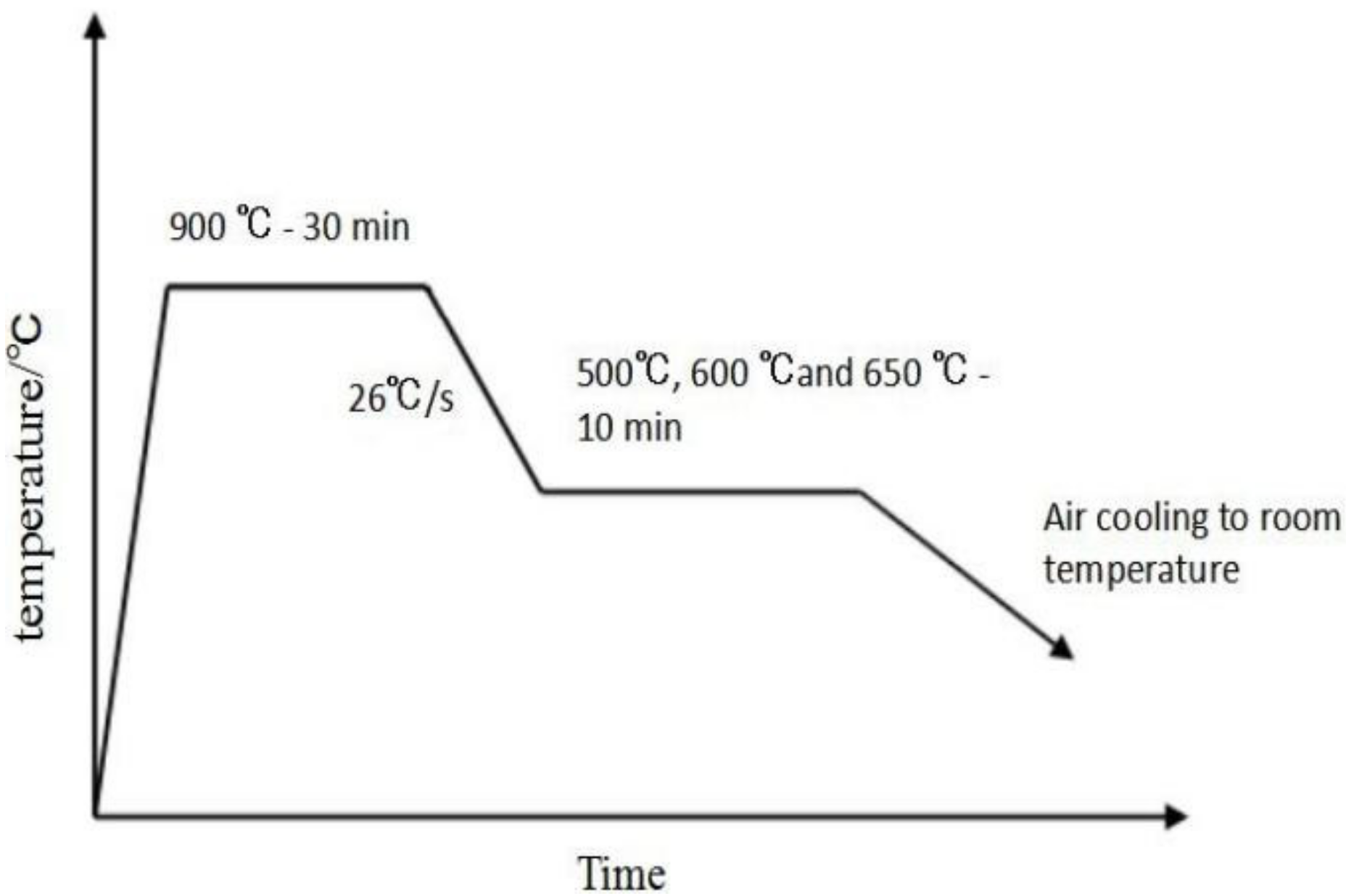

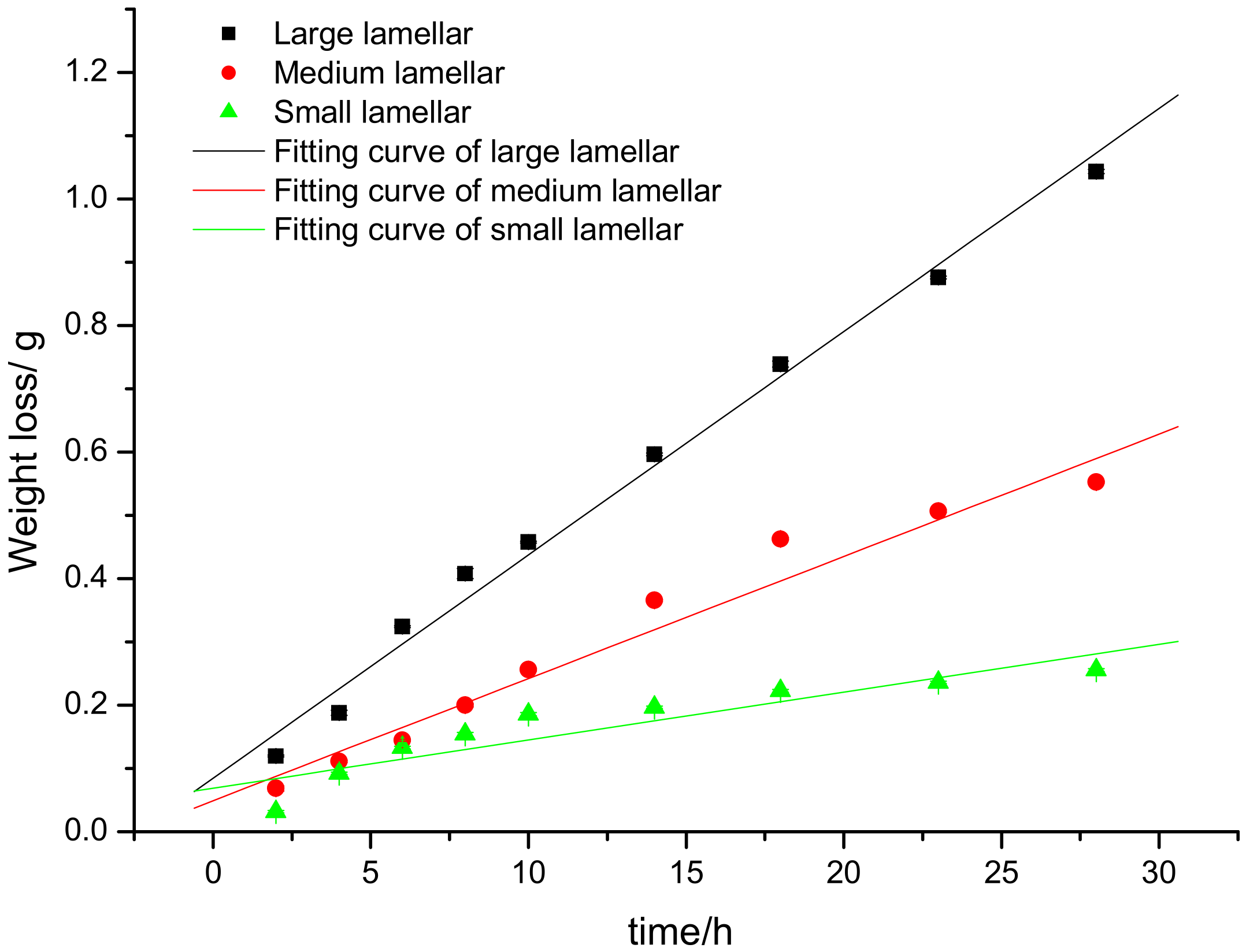
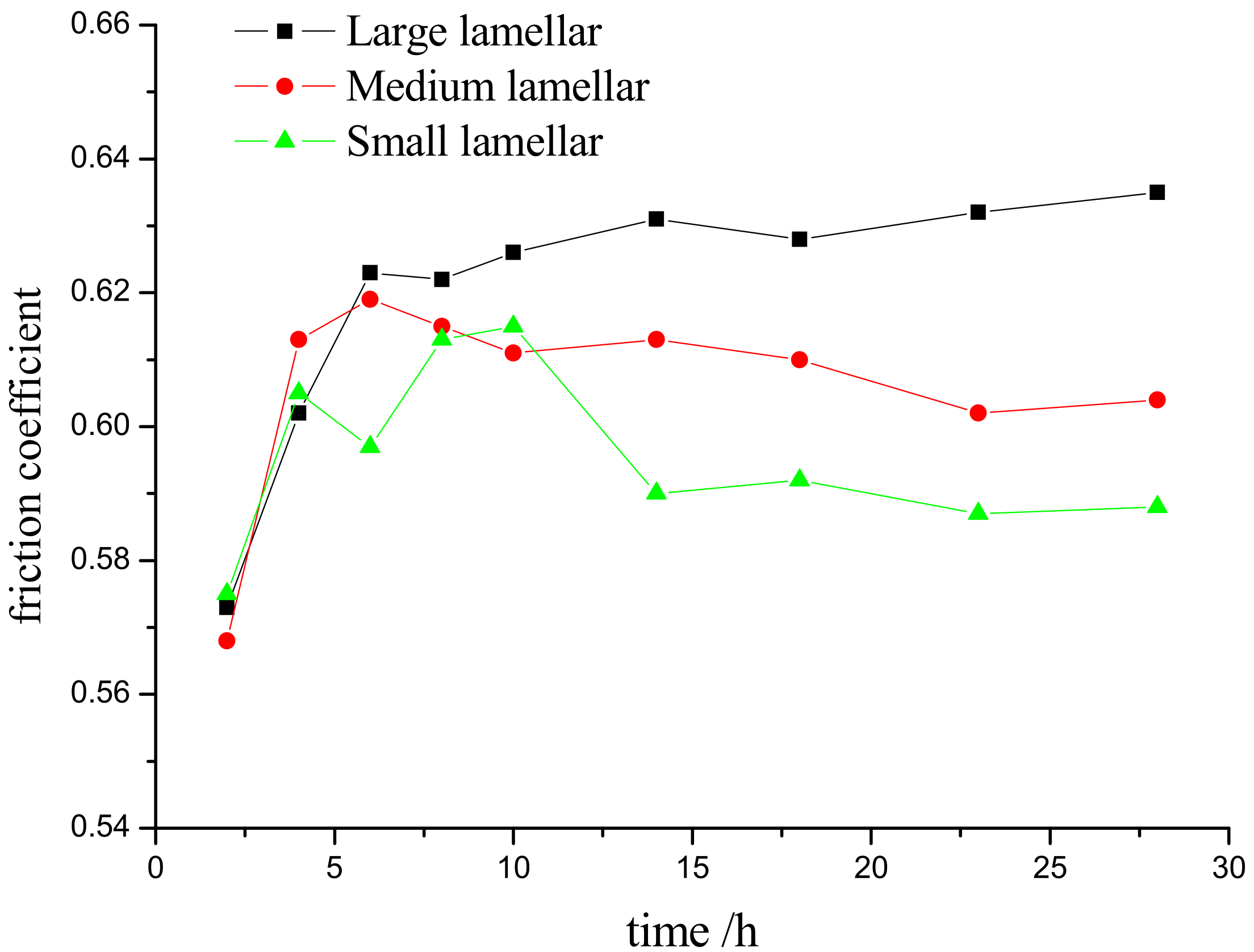
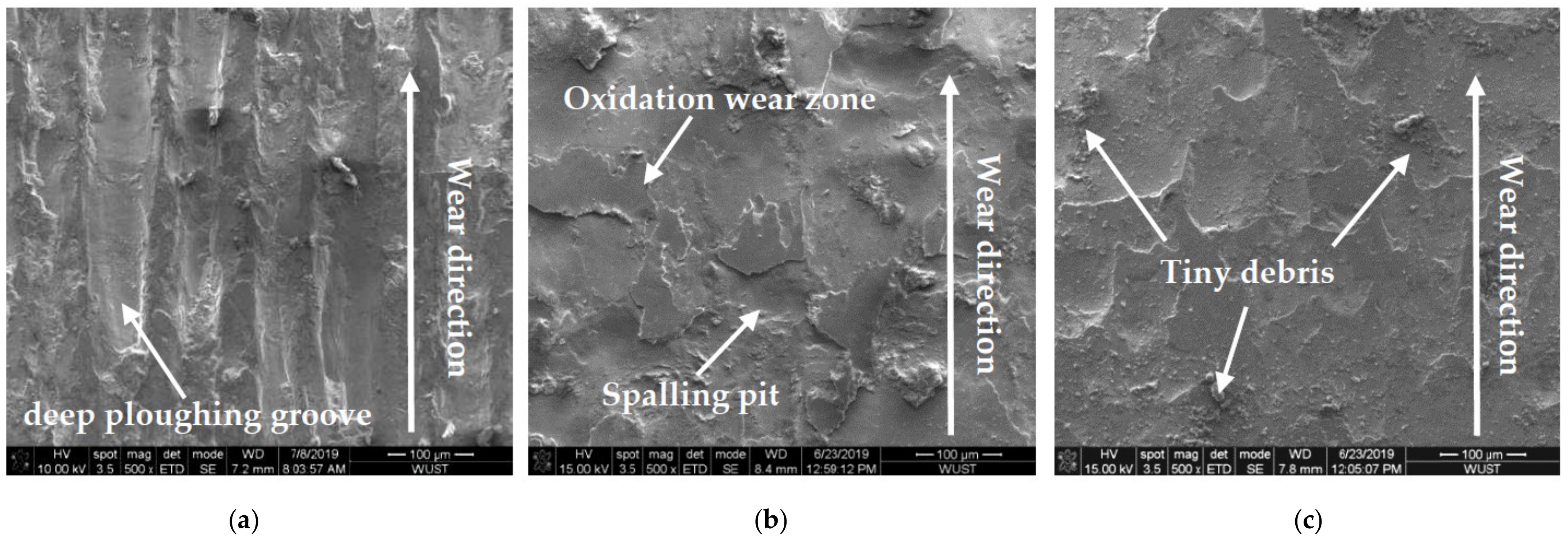

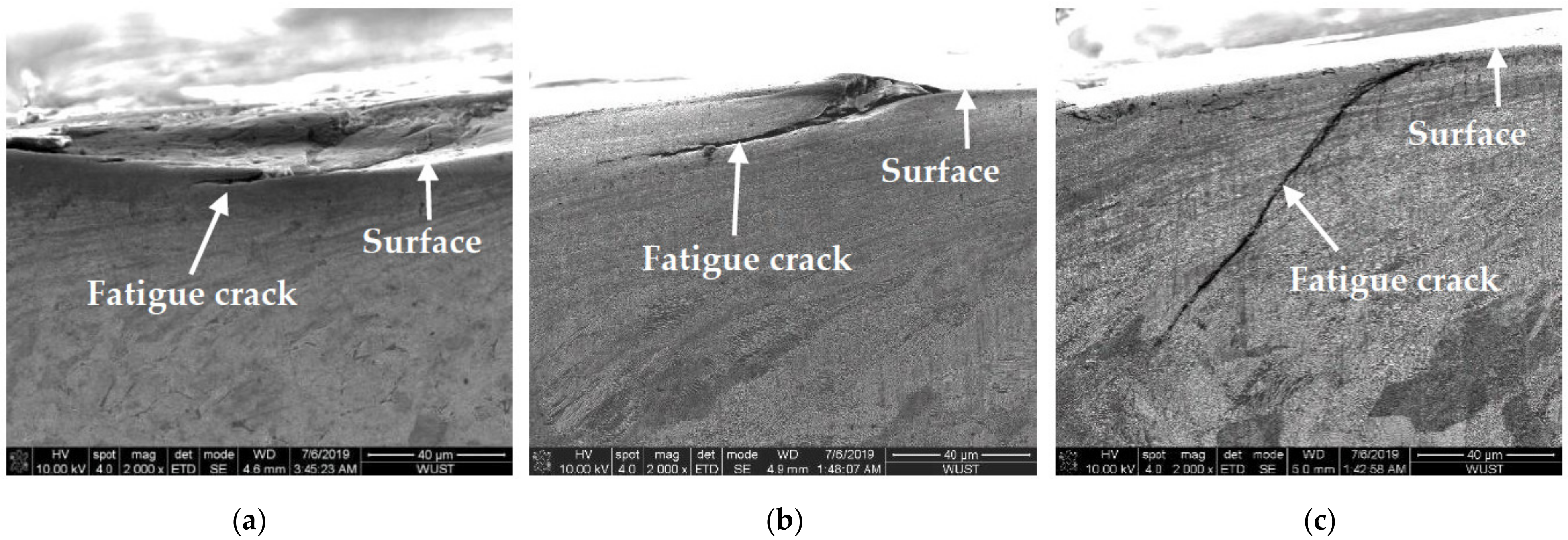
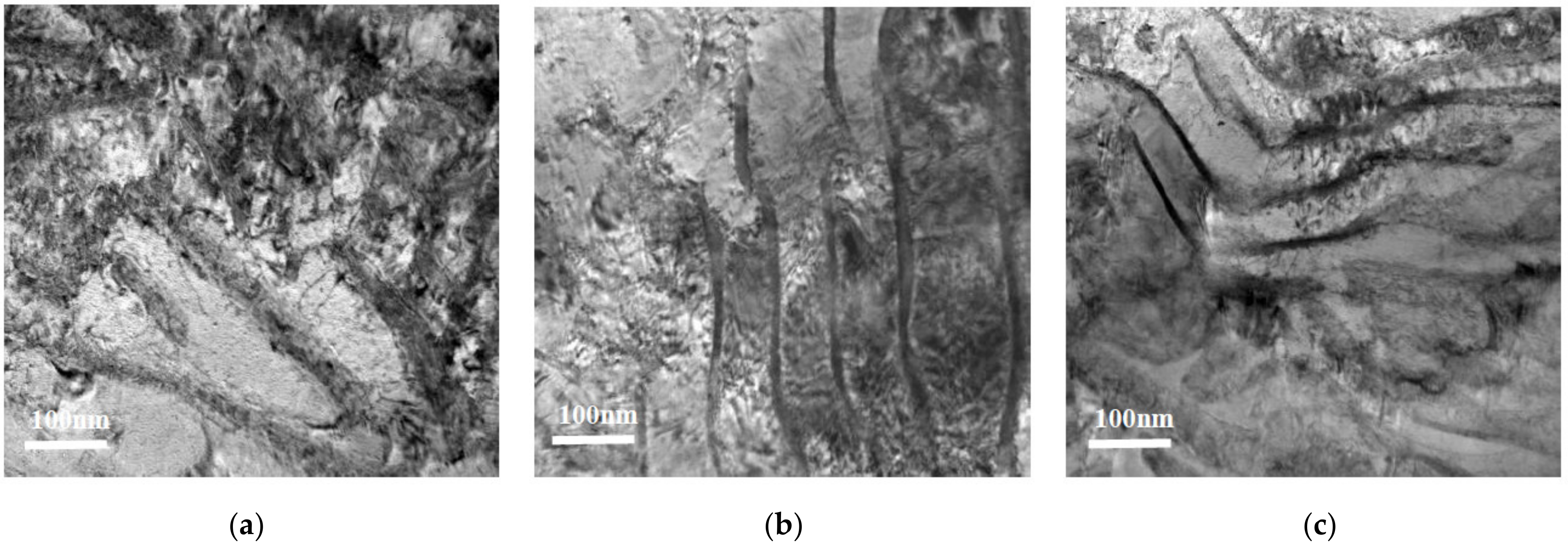
| Steels | C | Si | Mn | P | S | V |
|---|---|---|---|---|---|---|
| U75V rail steel | 0.76 | 0.67 | 0.91 | 0.012 | 0.008 | 0.06 |
| Wheel steel | 0.70 | 0.36 | 0.81 | 0.010 | 0.011 | 0.01 |
| measurement uncertainty | ±0.02 | ±0.02 | ±0.05 | +0.005 | +0.005 | ±0.01 |
| Samples | Isothermal Temperature/°C | Lamellar Spacing/nm | Tensile Strength/MPa | Elongation/% | Brinell Hardness/HB |
|---|---|---|---|---|---|
| Large lamellar | 650 | 263 | 1072 | 12.6 | 305 |
| Medium lamellar | 600 | 161 | 1213 | 12.1 | 358 |
| Small lamellar | 500 | 104 | 1306 | 11.4 | 383 |
| Samples | 2 h | 4 h | 6 h | 8 h | 10 h | 14 h | 18 h | 23 h | 28 h |
|---|---|---|---|---|---|---|---|---|---|
| Large lamellar | 0.118 | 0.187 | 0.323 | 0.41 | 0.459 | 0.596 | 0.739 | 0.878 | 1.043 |
| Medium lamellar | 0.069 | 0.113 | 0.145 | 0.197 | 0.258 | 0.366 | 0.461 | 0.509 | 0.551 |
| Small lamellar | 0.031 | 0.09 | 0.131 | 0.154 | 0.188 | 0.196 | 0.225 | 0.237 | 0.254 |
| Samples | 2 h | 4 h | 6 h | 8 h | 10 h | 14 h | 18 h | 23 h | 28 h |
|---|---|---|---|---|---|---|---|---|---|
| Large lamellar | 0.573 | 0.602 | 0.623 | 0.622 | 0.626 | 0.631 | 0.628 | 0.632 | 0.635 |
| Medium lamellar | 0.568 | 0.613 | 0.619 | 0.615 | 0.611 | 0.613 | 0.61 | 0.602 | 0.604 |
| Small lamellar | 0.575 | 0.605 | 0.597 | 0.613 | 0.615 | 0.59 | 0.592 | 0.587 | 0.588 |
| Samples | Hardness of Plastic Deformation Layer/HV | Hardness of Matrix/HV | Hardening Rate γ/% |
|---|---|---|---|
| Large lamellar | 392 | 313 | 25.24 |
| Medium lamellar | 496 | 378 | 31.22 |
| Small lamellar | 536 | 396 | 35.35 |
Disclaimer/Publisher’s Note: The statements, opinions and data contained in all publications are solely those of the individual author(s) and contributor(s) and not of MDPI and/or the editor(s). MDPI and/or the editor(s) disclaim responsibility for any injury to people or property resulting from any ideas, methods, instructions or products referred to in the content. |
© 2023 by the authors. Licensee MDPI, Basel, Switzerland. This article is an open access article distributed under the terms and conditions of the Creative Commons Attribution (CC BY) license (https://creativecommons.org/licenses/by/4.0/).
Share and Cite
Fei, J.; Zhou, G.; Zhou, J.; Zhou, X.; Li, Z.; Zuo, D.; Wu, R. Research on the Effect of Pearlite Lamellar Spacing on Rolling Contact Wear Behavior of U75V Rail Steel. Metals 2023, 13, 237. https://doi.org/10.3390/met13020237
Fei J, Zhou G, Zhou J, Zhou X, Li Z, Zuo D, Wu R. Research on the Effect of Pearlite Lamellar Spacing on Rolling Contact Wear Behavior of U75V Rail Steel. Metals. 2023; 13(2):237. https://doi.org/10.3390/met13020237
Chicago/Turabian StyleFei, Junjie, Guifeng Zhou, Jianhua Zhou, Xudong Zhou, Zhao Li, Duo Zuo, and Run Wu. 2023. "Research on the Effect of Pearlite Lamellar Spacing on Rolling Contact Wear Behavior of U75V Rail Steel" Metals 13, no. 2: 237. https://doi.org/10.3390/met13020237




